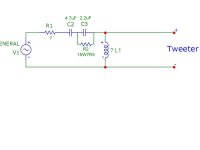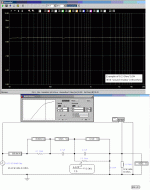Hi Guys. I have just changed my speakers to Paradigm Titans - vary nice speaker.
I wanted to chceck what is inside... And there it was.
Can you tell me what is the function of the R2 - and why it is 15W ceramic resistor?? Why Paradigm uses in parallel cap and the gigant resistor?
The second question is R1 - I don't know what it is. It is very smal like regular resistor seen in a cd player 0_0. Maybe 5mm long, 1mm thick - it has only one black stripe. The same question what it is doing there and why it is so small power rating thing[W].
Thanks for help. I have a plan to change the caps to JANTZEN SUPERIOR. But I don't know that to do withe the R1 and what to do with GIGANT 15W R2. It is in a signal path - if Soi would like to change it to MILLS resistor. But another question comes up - Can I use 5W resistor instead of the 15W?
Thanks for HELP!
I wanted to chceck what is inside... And there it was.
Can you tell me what is the function of the R2 - and why it is 15W ceramic resistor?? Why Paradigm uses in parallel cap and the gigant resistor?
The second question is R1 - I don't know what it is. It is very smal like regular resistor seen in a cd player 0_0. Maybe 5mm long, 1mm thick - it has only one black stripe. The same question what it is doing there and why it is so small power rating thing[W].
Thanks for help. I have a plan to change the caps to JANTZEN SUPERIOR. But I don't know that to do withe the R1 and what to do with GIGANT 15W R2. It is in a signal path - if Soi would like to change it to MILLS resistor. But another question comes up - Can I use 5W resistor instead of the 15W?
Thanks for HELP!

Attachments
Measure R1, maybe it's just a polyswitch. Leave R2, if you want Mills 5W, use 4 of them in series/parallel. C/R is a compensation, look here
http://www.diyaudioandvideo.com/Calculator/Contour/Help.aspx
http://www.diyaudioandvideo.com/Calculator/Contour/Help.aspx
Yes R1 is just ome kind of a jumper. I'll remove it since it is for sure degrading sound quality.
Thanks for the link that is What I was looking for!
Now everything is clear.
My question is still about this 15W resistor - since I don't use high power amp can I switch it to 5W? In all my previous speakers KEF, ELTAX, TANNOY, MISSION in series with tweeter was just standard 5W ceramic resistor.
Another option is 12W MILLS - and I think this would be safe? What do You think?
Thanks for the link that is What I was looking for!
Now everything is clear.
My question is still about this 15W resistor - since I don't use high power amp can I switch it to 5W? In all my previous speakers KEF, ELTAX, TANNOY, MISSION in series with tweeter was just standard 5W ceramic resistor.
Another option is 12W MILLS - and I think this would be safe? What do You think?
Should be fine, if you don't take it to max output and the signal doesn't overload or clips. For more power, with another amp or speakers, two 15R0 12W mills in parallel would also make a 7R5.
-.. - and why it is 15W ceramic resistor..
Hi,
Take a look at the submitted picture where your Tweeter is (if) supposed to be an 8 ohm device.
If you replace this resistor with a 5 W type, maximum input to the speaker cannot exceed 21.8 W before you smell smoke, that is if your tweeter have a similar load as the one in the simulation,of course.
By the way, there is no reason to use an expensive resistors.
IMO, in this application a wire-wound will do the job i as good as any other especially when paralleled with a capacitor.
I took an 50 cent 8.2 wire wound resistor and ran a Z plot ,the result is in the picture.
A loudspeaker is a system from a designers point of view where a single component plays a minor role.
Replacing existing components at random, without measuring the impact on the filter as a whole, even if using the same component value, is IMO not a good idea, but rather a recipe of ' high end' disaster where the improvement is often an illusion.
b
1(1)
Attachments
Thanks bjorno. Now I understand. I'm a beginner when it comes to loudspeakers crossovers design. I think that 5W is to small - 10/12W is a way to go in my setup.
When it comes to good quality parts - I have to disagree. In almost every setup I had changing resistors and caps in crossover was a hughe improvement in terms of sound quality.
Changing caps to good ones - Jantzen Superior/Silver / Mundorf and resistors to MILLS was always a big change. Always for good. Especially when duet electrolytics caps / ceramic resistors was in original.
Sometimes I bypass big MKP caps with a small 0.1uF PIO. Also with good results.
Since titans are not the most expensive... yet also not the cheapest ones - I think tak giving them a shot even when the benefit is small - it's worth the try.
I have already added 0.1uF PIO cap - improvement is significant - more detail, beter top end.
Titans have titanium tweeter - sometimes it's really detailed and bright. It's not harsh - just bright.
When it comes to good quality parts - I have to disagree. In almost every setup I had changing resistors and caps in crossover was a hughe improvement in terms of sound quality.
Changing caps to good ones - Jantzen Superior/Silver / Mundorf and resistors to MILLS was always a big change. Always for good. Especially when duet electrolytics caps / ceramic resistors was in original.
Sometimes I bypass big MKP caps with a small 0.1uF PIO. Also with good results.
Since titans are not the most expensive... yet also not the cheapest ones - I think tak giving them a shot even when the benefit is small - it's worth the try.
I have already added 0.1uF PIO cap - improvement is significant - more detail, beter top end.
Titans have titanium tweeter - sometimes it's really detailed and bright. It's not harsh - just bright.
- Status
- Not open for further replies.

